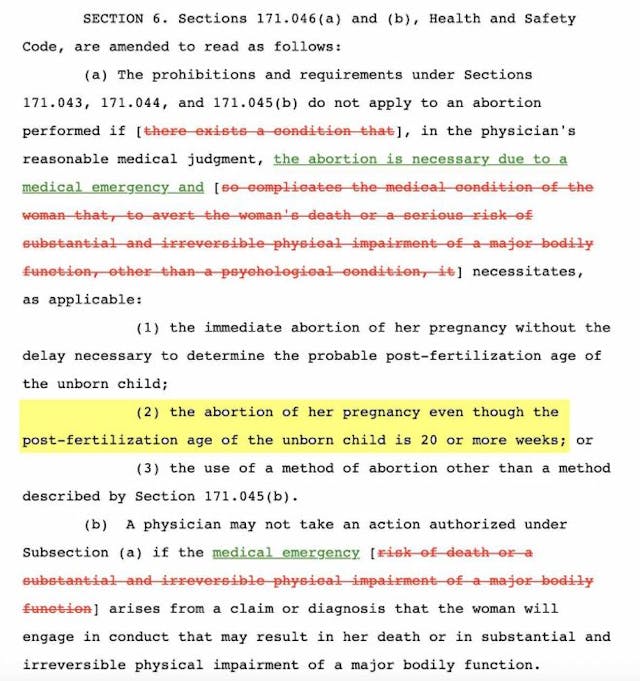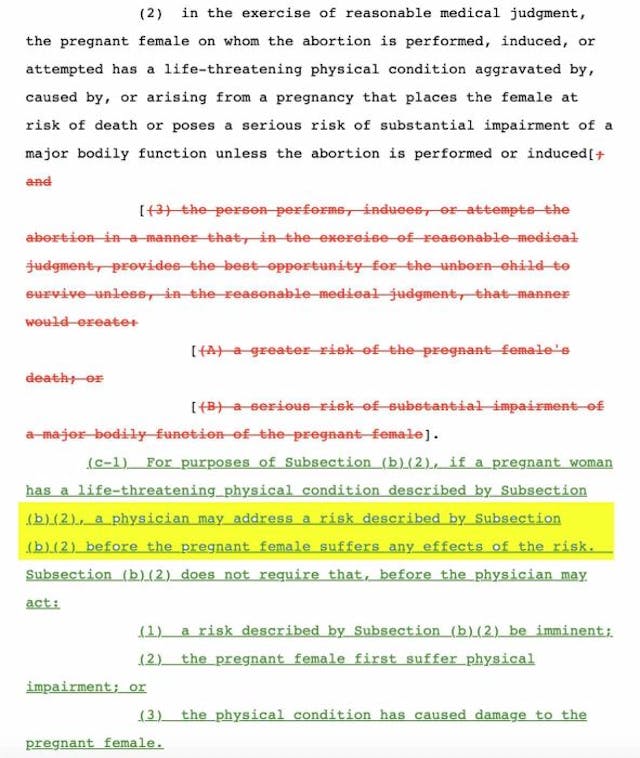
She instantly regretted taking the abortion pill. Then one pro-life sign changed everything
Andrea Trudden
·
Does the Texas ‘Life of the Mother Act’ clarify the state’s pro-life law… or weaken it?
Texas’s Life of the Mother Act, which aims to clarify the state’s Human Life Protection Act protecting most preborn children from induced abortion, received final approval in the Texas House on Thursday. It previously passed the state Senate in a unanimous vote in April, and will now head to the desk of Governor Greg Abbott.
Since the Human Life Protection Act was enacted in August of 2022, pro-abortion media outlets — most notably ProPublica — have been publishing propaganda conflating induced abortion (direct and intentional killing, as described by the law) with valid medical treatments such as miscarriage care and induced delivery.
The question is, are the new bill’s clarifications helpful — or do they create potentially dangerous loopholes?
The Life of the Mother Act allows for abortions — defined as the intent to cause the death of the child — past 20 weeks for “medical emergencies” — with no limit mentioned, regardless of the child’s ability to survive outside the womb.
The Act also allows abortion “before the pregnant female suffers any effects of the risk” and the condition “is not necessarily one actively injuring the patient.” It states: “Life threatening means capable of causing death or potentially fatal.”
Some abortionists have stated that pregnancy itself, regardless of any other condition, is a “potentially fatal” condition.
Given the 20+-week abortion allowance and the potential of loosely defining “potentially fatal” with no active injury to the patient necessary, there is concern that these changes create loopholes allowing abortion for any reason up to birth.
The Human Life Protection Act currently states that a person “may not knowingly perform, induce, or attempt an abortion.”
⇒What is an “abortion” under Texas law?
The state’s Health and Safety Code says abortion means (emphasis added):
… the act of using or prescribing an instrument, a drug, a medicine, or any other substance, device, or means with the intent to cause the death of an unborn child or a woman known to be pregnant….
⇒What isn’t an “abortion” under Texas law?
The Code states (emphases added):
An act is not an abortion if the act is done with the intent to: … save the life or preserve the health of an unborn child; … remove a dead, unborn child whose death was caused by spontaneous abortion; or … remove an ectopic pregnancy.
⇒What are the exceptions?
Texas Health and Safety Code Section 170A.022 lists exceptions to “prohibited abortions,” allowing abortions when (emphases added):
… in the exercise of reasonable medical judgment, the pregnant female on whom the abortion is performed, induced, or attempted has a life-threatening physical condition aggravated by, caused by, or arising from a pregnancy that places the female at risk of death or poses a serious risk of substantial impairment of a major bodily function unless the abortion is performed or induced;
… the person performs, induces, or attempts the abortion in a manner that, in the exercise of reasonable medical judgment, provides the best opportunity for the unborn child to survive unless, in the reasonable medical judgment, that manner would create:
(A) a greater risk of the pregnant female’s death; or
(B) a serious risk of substantial impairment of a major bodily function of the pregnant female.
The law notes, “Medical treatment provided to the pregnant female by a licensed physician that results in the accidental or unintentional injury or death of the unborn child does not constitute a violation of this section” (emphasis added).
It isn’t D&Cs for miscarriage or induced deliveries in medical emergencies like preterm premature rupture of membranes or preeclampsia that are prohibited by the law; it is the specific act of using procedures or drugs with the intention of ending the baby’s life.
Article continues below
Dear Reader,
In 2026, Live Action is heading straight where the battle is fiercest: college campuses.
We have a bold initiative to establish 100 Live Action campus chapters within the next year, and your partnership will make it a success!
Your support today will help train and equip young leaders, bring Live Action’s educational content into academic environments, host on-campus events and debates, and empower students to challenge the pro-abortion status quo with truth and compassion.
Invest in pro-life grassroots outreach and cultural formation with your DOUBLED year-end gift!
While the Life of the Mother Act makes some positive changes, such as updating the definition of ectopic pregnancy to be more specific, other changes are concerning.
⇒The Life of the Mother Act allows a preborn child to be intentionally killed “even though the post-fertilization age of the unborn child is 20 or more weeks…” Babies born as young as 21 weeks have been known to survive with proper medical care. Does this provision allow for the intentional killing of a preborn child up to birth?

⇒The Life of the Mother Act changes the definition of what constitutes a “life-threatening” condition in Texas.
Texas Health and Safety Code § 34.001 currently defines a “life-threatening condition” as “a condition from which the likelihood of death is probable unless the course of the condition is interrupted.”
BUT… the new Life of the Mother Act adds to the Code that a “life-threatening” condition is “capable of causing death or potentially fatal” and “is not necessarily one actively injuring the patient…”


This seemingly small change in definition could prove extremely dangerous in the hands of abortionists who believe pregnancy itself is ‘life-threatening’. It’s not a stretch; there are even judges willing to warp or ignore the idea of “reasonable medical judgment”:
Late-term abortionist Warren Hern repeatedly called pregnancy itself “life-threatening.”
Hern said, “Every pregnancy is a health issue! There’s a certifiable risk of death from being pregnant, period,” adding, “[Abortion] is a grotesque conversation to many people. But this is a surgical procedure for a life-threatening condition” (emphases added).
Hern also stated in more recent interview with Michael Shermer: “… [I]f the woman doesn’t want to be pregnant, there’s no justification for forcing her to continue the pregnancy… She has a potentially fatal illness, condition that can kill her – The medical problem is that she’s pregnant!” [emphasis added]
Planned Parenthood abortionists were classifying all abortions as “medically indicated” — and the courts let them continue.
A judge presiding over a 2015 Alaska court case determined that Planned Parenthood’s abortionists in the state could use their “professional judgment” to commit abortions “to prevent the death or disability of the woman, or to ameliorate a condition harmful to the woman’s physical or psychological health” (emphasis added) and still classify it under “medical necessity.” The State called this so “broad and nebulous” that the reasons could extend to “social and economic considerations.” Another judge upheld the order, allowing Planned Parenthood to classify essentially all Medicaid abortions under “medical necessity.”
Abortionists who testified in the case “never concluded that an abortion is other than medically indicated when a woman wishes to terminate her pregnancy,” and believed “if a patient has a problem and an abortion will help resolve the problem, the abortion is medically indicated” (emphasis added).
The Life of the Mother Act contains a section stating that attorneys are to be educated about “the circumstances under which a physician is required under Section 170A.0021, Health and Safety Code… to treat a pregnant female who experiences such conditions in a manner that maximizes an unborn child’s opportunity to survive if doing so does not increase the threat to the mother presented by those conditions.” But this seems little comfort in light of the bill’s other changes.
Could the wording of the Life of the Mother Act theoretically allow an abortionist to classify pregnancy itself as “life-threatening,” regardless of whether the mother has any other condition or risk factor, and abort her child?
Coupling this wording with the bill’s allowing of induced abortion (intentionally killing the child) later than 20 weeks, this has the makings of a recipe for abortion on demand without limit.
After the original Human Life Protect Act took effect in Texas, ProPublica and other pro-abortion media outlets went on the hunt for tragic anecdotes they felt they could use to create a narrative, claiming the pro-life law put women at risk.
Preventable and non-preventable maternal deaths happen in every state, regardless of the state’s abortion law, but ProPublica focused on pro-life states like Texas, blaming pro-life laws for women’s deaths. And yet, in apparent contradiction, ProPublica recently published the findings of its own analysis that revealed inconsistent hospital policies, not state pro-life laws, are contributing to women’s injuries and deaths.
Regardless, ProPublica’s prize-winning propaganda fulfilled its purpose, convincing countless readers — and, obviously, many Texas legislators — that the Human Life Protection Act required amending.
Lawmakers in the state created the Life of the Mother Act to provide clarity for hospitals and doctors who appear to be confused about the difference between intentionally causing the death of a preborn child and the unintentional death of a preborn child, according to state law.
But there are concerns that language in the new bill has the potential to undo many of the pro-life protections that the Human Life Protection Act intended.
Live Action News is pro-life news and commentary from a pro-life perspective.
Contact editor@liveaction.org for questions, corrections, or if you are seeking permission to reprint any Live Action News content.
Guest Articles: To submit a guest article to Live Action News, email editor@liveaction.org with an attached Word document of 800-1000 words. Please also attach any photos relevant to your submission if applicable. If your submission is accepted for publication, you will be notified within three weeks. Guest articles are not compensated (see our Open License Agreement). Thank you for your interest in Live Action News!

Andrea Trudden
·
Issues
Angeline Tan
·
Guest Column
Emily Berning
·
Opinion
Nancy Flanders
·
Opinion
Mark Wiltz
·
Opinion
Mark Wiltz
·
Human Interest
Nancy Flanders
·
Politics
Nancy Flanders
·
Human Interest
Nancy Flanders
·
Politics
Nancy Flanders
·
Human Interest
Nancy Flanders
·